AMD Athlon 64 4000+ & FX-55: A Thorough Investigation
by Anand Lal Shimpi on October 19, 2004 1:04 AM EST- Posted in
- CPUs
Workstation Applications
Visual Studio 6
Carried over from our previous CPU reviews, we continue to use Visual Studio 6 for a quick compile test. We are still using the Quake 3 source code as our test and measure compile time in seconds. The results are pretty much in line with what we've seen in the past.
Without compiler speed optimizations for NetBurst, the Pentium 4 architecture is not very well suited for highly branchy applications such as compiling and code optimization. The Athlon 64 is far better suited for this type of usage pattern and thus AMD wins the compiler test.
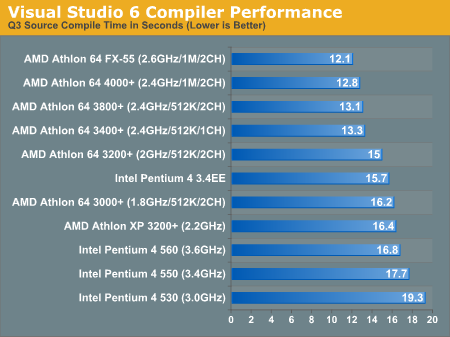
SPECviewperf 8
For our next set of professional application benchmarks we turn to SPECviewperf 8. SPECviewperf is a collection of application traces taken from some of the most popular professional applications, and compiled together in a single set of benchmarks used to estimate performance in the various applications the benchmark is used to model. With version 8, SPEC has significantly improved the quality of the benchmark, making it even more of a real world indicator of performance.
We have included SPEC's official description of each one of the 8 tests in the suite.
3dsmax Viewset (3dsmax-03)
"The 3dsmax-03 viewset was created from traces of the graphics workload generated by 3ds max 3.1. To insure a common comparison point, the OpenGL plug-in driver from Discreet was used during tracing.
The models for this viewset came from the SPECapc 3ds max 3.1 benchmark. Each model was measured with two different lighting models to reflect a range of potential 3ds max users. The high-complexity model uses five to seven positional lights as defined by the SPECapc benchmark and reflects how a high-end user would work with 3ds max. The medium-complexity lighting models uses two positional lights, a more common lighting environment.
The viewset is based on a trace of the running application and includes all the state changes found during normal 3ds max operation. Immediate-mode OpenGL calls are used to transfer data to the graphics subsystem."
The biggest surprise here is that there is a huge performance impact (13%) by moving down to a single channel memory subsystem with the Athlon 64. There are also a couple of other surprises, with the Pentium 4 560 doing surprisingly well, coming in at the heels of the Athlon 64 FX-55.
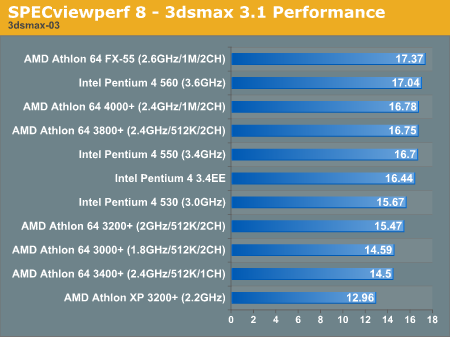
CATIA Viewset (catia-01)
"The catia-01 viewset was created from traces of the graphics workload generated by the CATIATM V5R12 application from Dassault Systemes.
Three models are measured using various modes in CATIA. Phil Harris of LionHeart Solutions, developer of CATBench2003, supplied SPEC/GPC with the models used to measure the CATIA application. The models are courtesy of CATBench2003 and CATIA Community.The car model contains more than two million points. SPECviewperf replicates the geometry represented by the smaller engine block and submarine models to increase complexity and decrease frame rates. After replication, these models contain 1.2 million vertices (engine block) and 1.8 million vertices (submarine).
State changes as made by the application are included throughout the rendering of the model, including matrix, material, light and line-stipple changes. All state changes are derived from a trace of the running application. The state changes put considerably more stress on graphics subsystems than the simple geometry dumps found in older SPECviewperf viewsets.
Mirroring the application, draw arrays are used for some tests and immediate mode used for others."
The single channel Athlon 64 3400+ does exceptionally poorly here, with the dual channel Athlon 64 parts holding a significant performance advantage. By now it's no surprise to see the FX-55, 4000+ and 3800+ at the top of the charts.
Interestingly enough, the CATIA benchmark appears to favor Intel's Prescott core over Northwood.

EnSight (ensight-01)
"The ensight-01 viewset replaces the Data Explorer (dx) viewset. It represents engineering and scientific visualization workloads created from traces of CEI's EnSight application.
CEI contributed the models and suggested workloads. Various modes of the EnSight application are tested using both display-list and immediate-mode paths through the OpenGL API. The model data is replicated by SPECviewperf 8.0 to generate 3.2 million vertices per frame.
State changes as made by the application are included throughout the rendering of the model, including matrix, material, light and line-stipple changes. All state changes are derived from a trace of the running application. The state changes put considerably more stress on graphics subsystems than the simple geometry dumps found in older viewsets.
Mirroring the application, both immediate-mode and display-list modes are measured."
No 925X based test system would complete this test, thus all we have are AMD chips to look at. Once again we see that the 3400+ is seriously crippled by its single channel memory interface.

Lightscape Viewset (light-07)
"The light-07 viewset was created from traces of the graphics workload generated by the Lightscape Visualization System from Discreet Logic. Lightscape combines proprietary radiosity algorithms with a physically based lighting interface.
The most significant feature of Lightscape is its ability to accurately simulate global illumination effects by precalculating the diffuse energy distribution in an environment and storing the lighting distribution as part of the 3D model. The resulting lighting "mesh" can then be rapidly displayed."
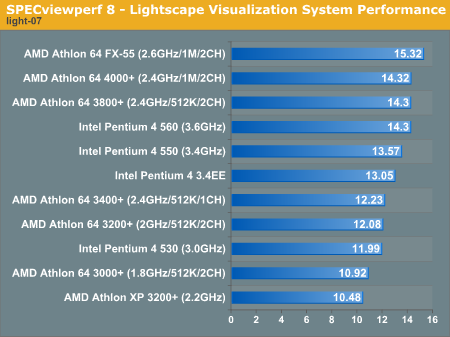
Maya Viewset (maya-01)
"The maya-01 viewset was created from traces of the graphics workload generated by the Maya V5 application from Alias.
The models used in the tests were contributed by artists at NVIDIA. Various modes in the Maya application are measured.
State changes as made by the application are included throughout the rendering of the model, including matrix, material, light and line-stipple changes. All state changes are derived from a trace of the running application. The state changes put considerably more stress on graphics subsystems than the simple geometry dumps found in older viewsets.
As in the Maya V5 application, array element is used to transfer data through the OpenGL API."
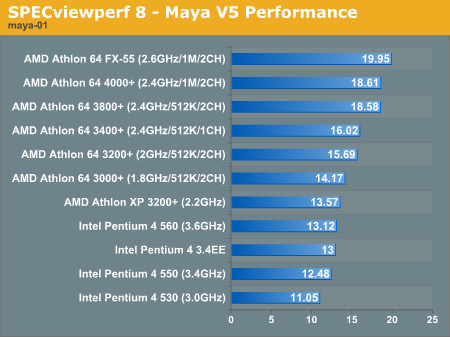
Pro/ENGINEER (proe-03)
"The proe-03 viewset was created from traces of the graphics workload generated by the Pro/ENGINEER 2001TM application from PTC.
Two models and three rendering modes are measured during the test. PTC contributed the models to SPEC for use in measurement of the Pro/ENGINEER application. The first of the models, the PTC World Car, represents a large-model workload composed of 3.9 to 5.9 million vertices. This model is measured in shaded, hidden-line removal, and wireframe modes. The wireframe workloads are measured both in normal and antialiased mode. The second model is a copier. It is a medium-sized model made up of 485,000 to 1.6 million vertices. Shaded and hidden-line-removal modes were measured for this model.
This viewset includes state changes as made by the application throughout the rendering of the model, including matrix, material, light and line-stipple changes. The PTC World Car shaded frames include more than 100MB of state and vertex information per frame. All state changes are derived from a trace of the running application. The state changes put considerably more stress on graphics subsystems than the simple geometry dumps found in older viewsets.
Mirroring the application, draw arrays are used for the shaded tests and immediate mode is used for the wireframe. The gradient background used by the Pro/E application is also included to better model the application workload."
When the Athlon was first released, it was a very solid performer in Pro/ENGINEER. But of course, back then, very few companies would think about Athlon workstations. With the Athlon 64 times have obviously changed, but the performance advantage does not seem to have changed at all, AMD continues to lead the way in the proe-03 viewset.

SolidWorks Viewset (sw-01)
"The sw-01 viewset was created from traces of the graphics workload generated by the Solidworks 2004 application from Dassault Systemes.
The model and workloads used were contributed by Solidworks as part of the SPECapc for SolidWorks 2004 benchmark.
State changes as made by the application are included throughout the rendering of the model, including matrix, material, light and line-stipple changes. All state changes are derived from a trace of the running application. The state changes put considerably more stress on graphics subsystems than the simple geometry dumps found in older viewsets.
Mirroring the application, draw arrays are used for some tests and immediate mode used for others."
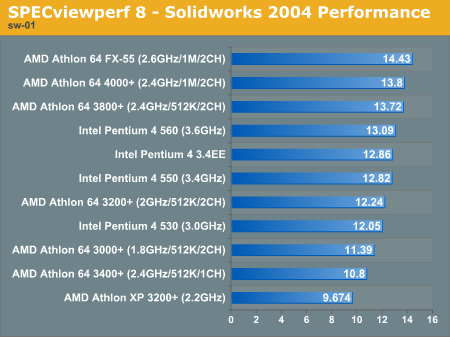
Unigraphics (ugs-04)
"The ugs-04 viewset was created from traces of the graphics workload generated by Unigraphics V17.
The engine model used was taken from the SPECapc for Unigraphics V17 application benchmark. Three rendering modes are measured -- shaded, shaded with transparency, and wireframe. The wireframe workloads are measured both in normal and anti-alised mode. All tests are repeated twice, rotating once in the center of the screen and then moving about the frame to measure clipping performance.
The viewset is based on a trace of the running application and includes all the state changes found during normal Unigraphics operation. As with the application, OpenGL display lists are used to transfer data to the graphics subsystem. Thousands of display lists of varying sizes go into generating each frame of the model.
To increase model size and complexity, SPECviewperf 8.0 replicates the model two times more than the previous ugs-03 test."
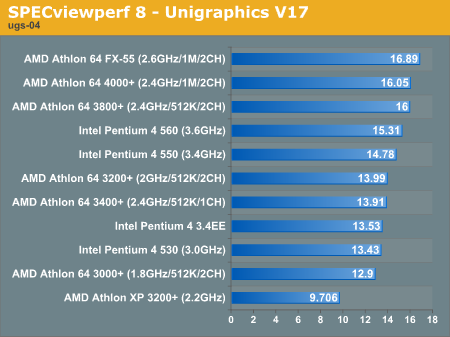










89 Comments
View All Comments
val - Wednesday, October 20, 2004 - link
for me is AMD unacceptable until there are good chipsets. All i have ever seen or had in my computers was big garbage with permanent problems and mysterious difficulties.Even SIS chipsets looks much better for intel than SIS for AMD. Its not anymore about CPU, CPU are fast for many tasks and that few percent of price or performance makes no deal, but overall quality talks strongly for Intel.
Save your time AMD fanboys to reply me something like that your AMD platform runs perfect and you had problems with intel and so on, its cheap and cannot anyway motivate me for change.
And yes, i have 2 AMD and 2 Intel computers and many i had or seen before (at home, work, school, projects, customers).
Gnoad - Wednesday, October 20, 2004 - link
3GHZ! Wow, I already was an AMD fan, but that just totally blows me away. Crazy stuff.GoHAnSoN - Tuesday, October 19, 2004 - link
nice article. Thxcoldpower27 - Tuesday, October 19, 2004 - link
Very nice, I await the day AMD releases a 3GHZ Athlon 64. These processor are niced but priced in a range where volumes are rather low, they have nice bragging rights though :PDa DvD - Tuesday, October 19, 2004 - link
3GHz on air :SAMD's really out of trouble for the coming year(s)
I can imagine K8@90nm scaling well beyond 3GHz...
(lol, or even top Prescott clockspeeds? That would be insane..)
Wesley Fink - Tuesday, October 19, 2004 - link
#30 and #43 -Once AMD informed us that strained silicon was used in the FX55 I couldn't resist a bit of a run with overclocking the FX55. The nForce4 Reference boad is not really intended or designed for overclocking, since it doesn't have any CPU or memory voltage adjustments. However it does support a wide range of multipliers so I could try a few settinngs.
I had no probelm at all running at 14.5X or 2.9GHz at default voltage. At that speed I ran quite a few benchmarks and a Quake 3 of 604.2 FPS. The FX55 actually booted at 3.0GHz but it never made it through a stable XP boot. I suspect with just a bit of CPU voltage 3.0GHz would be possible with the FX55 on air. All cooling was just the new AMD stock fan which now includes copper fins and heat pipes.
verybusy - Tuesday, October 19, 2004 - link
There is some FX55 and 4000+ overclocking info at http://www.hothardware.com/viewarticle.cfm?page=2&...Assuming that my request from above is granted regarding other overclocking of 3500+, 3200+ and 3000+, I'd like to see just how overclocking turns out with the retail heatsink and fan. I hope that's not too much of a request.
Thanks...
verybusy - Tuesday, October 19, 2004 - link
I liked the review of the Athlon 64 4000+ and FX-55 and it was nice to see it compared to the other Athlon 64 3200+ and 3000+ processors running at stock speeds.Unfortulately, with this review following so closely behind the 3500+ and 3000+ review (.09 Athlon 64: Value, Speed and Overclocking), it would have been very useful to see the 3500+, 3200+ and 3000+ overclocked to 2.6GHz as well. Afterall, the .09 3500+/3000+ @290x9 is faster than the FX53 (2.4GHz-1MB) err I mean Athlon 64 4000+). The overclocked 3500+, 3200+ and 3000+ could be pretty much as quick as the FX55 couldn't it?
That's what I want to see anyway.
ViRGE - Tuesday, October 19, 2004 - link
#39, Anand mentions that it's multiplier locked.Zebo - Tuesday, October 19, 2004 - link
Guys the 3400 newcastle is a way underated chip. It should have been, by all rights, called a 3600. I guess they did'nt want the 3500 to look bad agains a "old" 754 newcastle though.As for the review, total AMD performance domination at low relative speeds temps and power consumption.:) Youd have to be a fool to buy intels netburst crap right now.